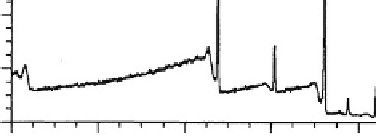Biomedical Engineering Reference
In-Depth Information
the need for experienced operators, and the cost associated
with this complex instrumentation. The vacuum limita-
tions can be sidestepped by using an ESCA system with
a cryogenic sample stage. At liquid nitrogen temperatures,
samples with volatile components, or even wet, hydrated
samples, can be analyzed.
The use of ESCA is best illustratedwith a brief example.
A poly(methyl methacrylate) (PMMA) ophthalmologic
device is to be examined. Taking care not to touch or
damage the surface of interest, the device is inserted into
the ESCA instrument introduction chamber. The in-
troduction chamber is then pumped down to 10
6
torr
(1.33
10
4
Pa) pressure. A gate valve between the in-
troduction chamber and the analytical chamber is opened
and the specimen ismoved into the analysis chamber. In the
analysis chamber, at 10
9
torr (1.33
10
7
Pa) pressure,
the specimen is positioned (on contemporary instruments,
using a microscope or TV camera) and the X-ray source is
turned on. The ranges of electron energies to be observed
are controlled (by computer) with the retardation lens on
the spectrometer. First, a wide scan is made in which the
energies of all emitted electrons over, typically, a 1000 eV
range are detected (
Fig. 3.1.4-8
). Then, narrow scans are
made in which each of the elements detected in the wide
scan is examined in higher resolution (
Fig. 3.1.4-9
).
Fromthewide scan, we learn that the specimen contains
carbon, oxygen, nitrogen, and sulfur. The presence of sulfur
and nitrogen is unexpected for PMMA. We can calculate
elemental ratios from the wide scan. The sample surface
contains 58.2% carbon, 27.7% oxygen, 9.5% nitrogen, and
4.5% sulfur. The narrow scan for the carbon region (C1s
spectrum) suggests four species: hydrocarbon, carbons
singly bonded to oxygen (the predominant species), car-
bons in amide-likemolecular environments, and carbons in
acid or ester environments. This is different from the
spectrum expected for pure PMMA. An examination of
Table 3.1.4-4 Information derived from an ESCA experiment
In the outermost 100
˚
of a surface, ESCA can provide:
Identification of all elements (except H and He) present at
concentrations >0.1 at %
Semiquantitative determination of the approximate elemental
surface composition (10%)
Information about the molecular environment (oxidation state,
bonding atoms, etc.)
Information about aromatic or unsaturated structures from shake-up
p* ) p
transitions
Identification of organic groups using derivatization reactions
Nondestructive elemental depth profiles 100
˚
into the sample and
surface heterogeneity assessment using angular-dependent ESCA
studies and photoelectrons with differing escape depths
Destructive elemental depth profiles several thousand angstroms into
the sample using argon etching (for inorganics)
Lateral variations in surface composition (spatial resolution
8-150 mm, depending upon the instrument)
''
Fingerprinting'' of materials using valence band spectra and
identification of bonding orbitals
Studies on hydrated (frozen) surfaces
directly in the analysis chamber for study. The disadvan-
tages include the need for vacuum compatibility (i.e., no
outgassing of volatile components), the vacuum environ-
ment (particularly for hydrated specimens), the possibility
of sample damage by X-rays if long analysis times are used,
A
B
12
O 1s
C
100Å
D
G
E
C 1s
F
N 1s
O auger
S 2p
S 2s
Fig. 3.1.4-7 ESCA is a surface-sensitive method. Although the
X-ray beam can penetrate deeply into a specimen, electrons
emitted deep in the specimen (D, E, F, G) will lose their energy in
inelastic collisions and never emerge from the surface. Only those
electrons emitted near the surface that lose no energy (A, B) will
contribute to the ESCA signal used analytically. Electrons that lose
some energy but still have sufficient energy to emerge from the
surface (C) contribute to the background signal.
0
1000
800
600
400
200
0
Binding energy (eV)
Fig. 3.1.4-8 ESCA wide scan of a surface-modified
PMMA ophthalmologic device.












































